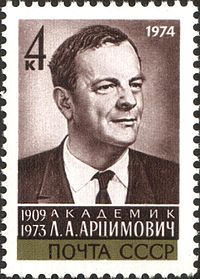Biography
Artsimovich was born on 25 February 1909 in Moscow in the Russian Empire. His family had Polish nobility roots;: 169 nonetheless, he was described as Russian by his autobiographer in 1985.: 71 His grandfather, a professor, was exiled to Siberia after the Polish uprising against Tsarist Russia in 1863 and married a Russian woman, later settling in Smolensk.: 166 His father was educated at Lviv University; his mother was a pianist trained in Switzerland.: 166 In 1923, Soviet authorities moved the Artsimovich family (due to suspicion of Anti-bolshevist activity) to Minsk, where he found employment in the railroad industry and started training towards becoming a railroad engineer. After his father found employment at Belarus State University, Artsimovich was able to attend the physics program at Belarus State University, and graduated with a specialist degree in physics in 1928–29.: 136–137 After moving to Moscow, he found employment in Artem Alikhanian's laboratory, and joined the staff at the Ioffe Institute in 1930.: 167
Initially, he worked on problems relating to nuclear physics and unsuccessfully defended his thesis for a Candidate of Sciences degree in 1937 and in 1939 at the Leningrad Polytechnical Institute, receiving only a written endorsement from the Ioffe Institute.: 170–171 During his lifetime, Artsimovich was recommended by many leading Soviet physicists to be conferred a Doktor Nauk (a Russian PhD), but the recommendations were later dismissed.: 137, 139
In 1945, Artsimovich joined the Soviet program of nuclear weapons, working on an electromagnetic method of isotope separation of uranium at Laboratory No. 2 along with Isaak Pomeranchuk. He was given Russian espionage files from Soviet agencies on the Manhattan Project's electromagnetic method.: 123 But the uranium enrichment under Artsimovich failed when it proved too costly since the electricity required for this work could not be produced by the Soviet power grid at that time.: 171 Despite being removed by Beria, Artsimovich continued work on gas discharges with support from Kurchatov at his Laboratory No. 2. After 1949, his work focused on the field of nuclear fusion by producing lithium-6 for the RDS-6s device. : 101
From 1951 to his death in 1973, Artsimovich was the head of the fusion power program in the former Soviet Union and became known as "the father of the Tokamak", a special concept for a fusion reactor. Once Artsimovich was asked when the first thermonuclear reactor would start its work. He replied: "When mankind needs it, maybe a short time before that."
In 1953, he became an academician of the Soviet Academy of Sciences and then a member of its Presidium in 1957. From 1963 to 1973, he was vice-chairman of the Russian chapter of the Pugwash Committee and chairman of the National Committee of Soviet Physicists. In 1966, he visited the United States to deliver a lecture on fusion and Tokamak technology at MIT, and was elected a Foreign Honorary Member of the American Academy of Arts and Sciences. On 1 March 1973, Artsimovich passed away due to cardiac arrest in Moscow. The crater Artsimovich on the Moon is named after him.
